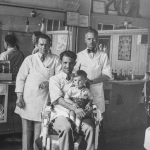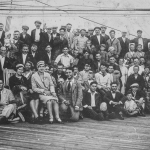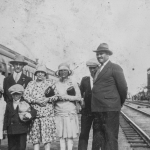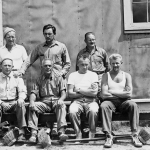With the ending of the First World War, the Government of Canada amended the 1910 Immigration Act.[1] The 1919 amendment was prompted by growing anti-foreign sentiment targeted at war-time enemy countries and enemy aliens residing in Canada; labour unrest blamed on “the foreign element”; and the post-war economic downturn. It barred immigration from enemy countries and expanded restrictions on so-called dissidents. Cabinet could also restrict immigration based on nationality, race, occupation and class and exclude people who had “peculiar customs, habits, modes of life and methods of holding property.” The last clearly refers to the Russian Revolution’s challenge to traditional land ownership.[2] While Italians were not enemy aliens, these restrictions were applied to them and the impact on Italian immigration to Alberta can be seen in the following census statistics noting the Italian population: 1921, 4,028; 1931, 4,766; and 1941, 4,872. In a period of 20 years, the number of people of Italian ethnicity in Alberta increased by only 844.
The small increase in numbers of Italians resulted from in-migration from other regions and family reunification. Many retiring miners came to Edmonton. Enrico Butti Senior came to Canada in 1912 under a mining contract as an electrical engineer and worked in the Crowsnest Pass in the electrification of the mines as did his son, Enrico [Henry], Junior. The family moved to Edmonton in 1925 and set up an electrical business. Henry Junior married Mira (Myra) Cantera of an Edmonton pioneer family in 1929 and, for a time, worked at the University of Alberta’s power plant. Other miners from the Crowsnest Pass and Coal Branch who settled in Edmonton were Tony Nimis, who worked in construction, and Valentino Dotto and his twin sons. In 1920, Fedele Nigro, whose father Antonio had worked in the mines and railway construction in BC at the end of the nineteenth century, moved his family from Winnipeg to Clyde, Alberta where he farmed and raised draft horses for road construction. The family moved to Edmonton in 1925 and Nigro partnered with James Anselmo on roadwork contracts including the Alaska Highway (1942).
Family reunification brought Robert Candido and Sam Scrivano to Edmonton. Robert’s aunt, Maria Zuchett, lived in Rossdale and arranged the marriage, in 1919, between her widowed sister, Robert’s mother, in Italy with one of her boarders, Joe Petri. Scrivano was sponsored, in 1923, by his sister Assunta Gaudio. His brother-in-law got Scrivano a job with the CNR where he worked for 42 years. In 1925, he returned to Italy to marry and brought his wife Maria to Edmonton. This was the pattern for many single men whose families’ arranged marriages in Italy, and the basis for family reunification.
The rise of Fascism in Italy under Benito Mussolini and his becoming the youngest Prime Minister, after the March on Rome in October 1922, would have unexpected impacts on Alberta’s Italian communities. This occurred through the influence of consular agent Felice de Angelis, a founder of the Venice agricultural colony in 1914. De Angelis made several trips back to Italy and became a supporter of Mussolini. In January, 1923, Italia Garibaldi, granddaughter of Giuseppe Garibaldi, a founder of the modern Italian state, visited Edmonton and Calgary, the Venice Colony and a new irrigation district near Lethbridge where the Government of Alberta was promoting settlement. This was part of a Canadian tour to promote Italian Fascism and agricultural colonization. Garibaldi was welcomed by George Hoadley, provincial Minister of Agriculture, and the media. In 1924, a fascio (Fascist local) was set up in Venice and, subsequently, in Edmonton, Calgary, Lethbridge and Medicine Hat. These were among the earliest in Canada. The Calgary Herald of December 8, 1926 reported: “Alberta Fascisti Forge Firm Ties Through Province,” and noted: “F. de Angelis, royal Italian consul at Edmonton, was elected provincial president.” I. Rader, consul for Calgary and Lethbridge became vice president, and A. Rebaudengo, Calgary, became secretary. Three attendees from Edmonton were mentioned: P. Butti, M. Sestini and A. Gottarolo.
What was the nature of these organizations? According to oral history interviews, they appear to have been largely social in nature and a manifestation of Italian patriotism. Black shirts and Fascist rosettes were worn at community events. Venice received funding and textbooks from the Italian government to set up an Italian school. It was run by Mary (Biollo) Doyle, whose father O.J. Biollo was a founder of the colony. Pietro Colbertaldo, an Edmonton-based watchmaker and jeweler, succeeded de Angelis as Italian consul in Edmonton, and was followed by Victor Losa who came to Edmonton and took over Colbertaldo’s business. They kept the local community informed of what was happening in Italy and also sought support for Fascist policies. While members of the community were largely naturalized Canadians and felt strong ties with their homeland, their children had been born in Canada and considered themselves Canadian.
Whether any members of the Alberta Fasci would have entered the war on the Italian side, or committed subversive acts, is open to question. What can be said is that many community members were in awe of the consuls and consular agents and, while Mussolini was admired by western leaders for the revitalization of Italy, it would have been natural to feel pride in their homeland. This changed, however, when Mussolini signed a pact with Hitler and sought to build an Italian empire by attacking Abyssinia (Ethiopia) in 1935, and occupying Albania in 1939.
Italy’s declaration of war on Britain, France and Allies on June 10, 1940 brought Canada into the war. Prime Minister W.L. Mackenzie King invoked the War Measures Act and, under the Security of Canada Regulations, more than 600 Italian-Canadians were deemed enemy aliens, arrested and interned in camps in Kananaskis, Alberta; Petawawa, Ontario; and Gagetown, New Brunswick. Italian citizens, naturalized Canadians and born Canadians were caught in the net. Evidence for arrests was not ironclad and, in some instances, fellow Italians denounced others simply because of old quarrels. Albertans interned were O.J. Biollo and Rudolph Michetti from Venice; Antonio Rebaudengo from Calgary, who had arrived from Italy in spring 1922 with his wife and infant son; Emilio Sereni, a farmer from Balzac, Alberta, who had obtained Canadian citizenship in 1904; and Giovanni (Johnny) Galdi, who arrived in 1914 and worked in the mines in Nordegg. Most were released within a year but Michetti served almost two years and Rebaudengo until September 1943 when Italy was defeated by the Allies.
Many members of Alberta’s Italian community were designated enemy aliens and had to report to the RCMP. There were more than 31,000 Italian enemy aliens in Canada as a whole. Enrico Butti, whose father was a member of the Edmonton Fascio, was investigated as President of Edmonton’s Italian Society. He had assumed that, because he was under the age of 21 when his Father became a Canadian citizen in the1920s, he was also a citizen. The RCMP told him that this was not so and he was advised not to leave town. Butti pointed out that his work as an electrician required him to travel around the Province and, eventually, they turned a blind eye. Whether the treatment from the RCMP was benevolent, or not, depended on the region and individual officers.
Assunta Paron arrived in Alberta’s Coal Branch, in 1939, where her father was working and with family members and friends had to report to the RCMP. This continued, in 1942, when she moved to Edmonton to work at the Great Western Garment Company. Her future husband, Gus Dotto, a miner in Cadomin, was serving in the Canadian Army as did many men of Italian ancestry. Victor Losa, consular agent and later Regente Consolare, based in Edmonton, was not interned but did have to report to the RCMP.
Enemy alien designation impacted the entire community. For many, all aspects of their “Italianness” – language, names and associations – were suppressed. When the post-war generation of immigrants arrived in Alberta, they found no Italian societies to ease their way.
Adriana Davies © 2016
Click to continue reading Adriana Davies’ chronicle There Were No Safety Nets, Part 3: Edmonton’s Italian Community, 1949 to the Present
Sources:
Bonifacio, Tony. “Venice Alberta 1914: The Pioneers and Others that Lived There.” Unpublished history of Venice, ca.1990s.
Canton, Licia, Domenic Cusmano, Michael Mirolla and Jim Zucchero, eds. Beyond Barbed Wire: Essays on the Internment of Italian Canadians. Edited by Licia Canton, Domenic Cusmano, Michael Mirolla and Jim Zucchero. Toronto: Guernica, 2012.
Davies, Adriana A. “Edmonton’s Italian Community.” In Celebrating Alberta’s Italian Community website. Heritage Community Foundation: Alberta Online Encyclopedia, retrieved May 20, 2016.
————. “A Settlement History of Alberta,” unpublished manuscript, 2011.
————. “Black Shirted Fascisti Come to Alberta,” unpublished manuscript, 2011.
————. “The Black-Shirted Fascisti Are Coming to Alberta,” 251-272. In Beyond Barbed Wire: Essays on the Internment of Italian Canadians. Edited by Licia Canton, Domenic Cusmano, Michael Mirolla and Jim Zucchero. Toronto: Guernica, 2012.
Mary N. B. Boyle Fonds, 1912 – [1973]. Provincial Archives of Alberta, PR1372.
Perin, Roberto, and Franc Sturino, eds. Arrangiarsi: The Italian Immigration Experience in Canada. Montreal: Guernica Editions, third edition, 2006.
Oral Histories:
Dante Alighieri Oral History Collection, 1973-1974. Provincial Archives of Alberta, PR0915.
Italians Settle In Edmonton Society Oral History Collection, 1982-1983. Provincial Archives of Alberta.
Heritage Community Foundation Celebrating Alberta’s Italian Community Oral History Collection, 2001 – 2002. University of Alberta Archives.
Footnotes:
[1] The 1910 Immigration Act increased the list of prohibited immigrants and expanded Cabinet’s power on admissibility and deportation. Immigrants “unsuited to the climate or requirements of Canada” were barred and charities could no longer sponsor immigrants. See Museum of Immigration at Pier 21 for a summary of relevant legislation, URL: https://www.pier21.ca/research/immigration-history/canadian-immigration-acts-and-legislation, retrieved May 24, 2016. See also Canadian Council for Refugees website, URL: http://ccrweb.ca/en/hundred-years-immigration-canada-1900-1999, retrieved May 24, 2016.
[2] See Canadian Council for Refugees, “A Hundred Years of Immigration to Canada 1900 to 1999” timeline. The 1923 entry notes: “The door opened to British subjects, Americans and citizens of “preferred countries” (Norway, Sweden, Denmark, Finland, Luxembourg, Germany, Switzerland, Holland, Belgium and France). Only agriculturalists, farm labourers, domestics and sponsored family members could be admitted from “non-preferred” countries: Austria, Hungary, Poland, Romania, Lithuania, Estonia, Latvia, Bulgaria, Yugoslavia and Czechoslovakia. Southern Europe was not even mentioned.” URL: http://ccrweb.ca/en/hundred-years-immigration-canada-1900-1999, retrieved May 25, 2016.






